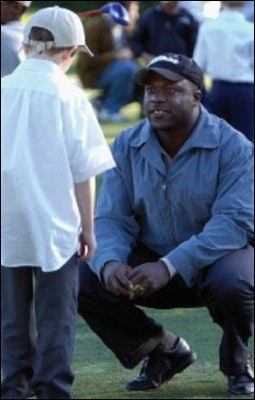Junior golf programs use the course to teach youths about the game of life

One visit from the world's best golfer just wasn't enough. As soon as the private jet carrying Tiger Woods lifted off the tarmac at the Greater Rockford (Ill.) Airport, area residents began strategizing ways to entice Woods into returning for another two-day youth golf clinic sponsored by the foundation that bears his name.
"People in the community were asking each other, 'What do we do next.' " recalls Nancy Kauzlarich, golf operations manager for the Rockford Park District.
It wasn't long before Rockford residents came up with an answer. "We decided we needed a place for kids," Kauzlarich says. Since Woods visited Rockford in June 2001, the community has joined forces to develop not one, but two places for kids to learn the game of golf.
The first facility, the Wee Course - formerly a driving range at the park district's Ingersoll Golf Course - has been renovated to include a 9,000-square-foot putting green, a 6,000-square-foot short-game station, a junior driving range and four par-3 holes, the greens of which are covered in synthetic turf to accommodate large groups. Soon after the $360,000 facility opens early this summer, the second learning center is expected to break ground on land just to the south, adding nine more holes exclusively for youth play.
Once complete, these facilities will become the permanent home for the local chapter of The First Tee - a World Golf Foundation initiative that uses golf to teach young people life skills - as well as accommodate the Rockford Park District's version of LPGA-USGA Girls Golf, a national program that introduces girls ages 7 to 17 to the sport. Administered jointly by the Ladies Professional Golf Association Foundation and the United States Golf Association, LPGA-USGA Girls Golf exposes 4,000 girls annually to golf at more than 130 sites nationwide, a number of which are municipal golf courses.
LPGA-USGA Girls Golf program sites host year-round activities such as holiday shootouts, mother/daughter clinics and derby days, meeting monthly during the school year and weekly during the summer. On the golf course, the program takes participants through a five-level progressive learning system, starting from the green and moving back to the tee, and also teaches golf rules and etiquette.
The greatest benefit of LPGAUSGA Girls Golf, says LPGA programs manager Sherry Greene, is that young girls are able to learn the game in a non-threatening environment. "With a lot of junior golf programs, the girls go out there and it's mostly boys, so they get discouraged," she says. "In our program, girls play with girls, and steadily gain the confidence to play with anybody."
Aside from introducing youths to one of the most popular lifetime sports and developing a corps of future municipal course patrons, junior golf programs can also bestow upon youths some valuable life lessons. For that reason, Lisa Masters, head golf professional for the Three Rivers Park District, which serves two counties just west of Minneapolis, believes such programs can be equally beneficial for at-risk youths and those from stable homes. "It's a misconception that The First Tee is only for underprivileged kids," she says. "I'm servicing a large area with mostly suburban kids. Every kid is the right kid for this program."
That's because every kid struggles during the transition into adolescence and eventual adulthood, says Masters, who clearly recalls dealing with her own frustrations as a teenager. "I remember how angry I used to get on the course when I was a kid. I usually ended up offending someone or having a bad round," she says. "Hopefully, kids can draw from their experiences here and use what they learned from us in school or later on in life."
The First Tee's curriculum focuses on nine core values: responsibility, sportsmanship, perseverance, confidence, judgment, honesty, respect, courtesy and integrity. Life Skills & Golf Experience training sessions - administered by PGA- or LPGA-certified teaching professionals who are assisted by volunteers, including high school golf coaches, recreation professionals and parents - are part golf, part classroom. The idea is to deliver activity-based lessons that empower youths, take the emphasis away from winning and losing, and instead reinforce the importance of focusing on the process itself.
"Golf provides a perfect venue for teaching lessons. Don't get me wrong - there are some kids who can flat-out play. But even some of our teaching professionals have said they like the Life Skills curriculum because it teaches kids to focus," says Amy Caruso, The First Tee's communications director. "For example, they learn respect - not just for others, but for themselves and their bodies, which carries over into thinking about what they put into their bodies."
The philosophy behind Hook A Kid On Golf, an initiative of the National Alliance for Youth Sports, isn't quite as progressive. Its mission, similar to that of LPGA-USGA Girls Golf, is simply to provide communities comprehensive youth golf programs without the obstacles that generally keep kids from learning golf. For some families, cost is the greatest inhibitor. To that end, Hook A Kid On Golf has partnered with the USGA to provide matching grant opportunities for its nearly 150 program sites nationwide. In 2002, the USGA doled out more than $130,000 in grants to 115 sites.
Most sites use the grant money to subsidize their programs, preventing youths from bearing any financial burden for registering for Hook A Kid On Golf's three programs - the week-long Tee Level Introductory Clinic, the intermediate Green Level Training Program or the summer-long Challenge Golf League. Participants of the Tee Level clinics, for example, receive a starter set of clubs, a golf bag, a golf shirt, a cap, golf balls and a one-year golf magazine subscription - all at a cost of $100 per participant. "We're able to provide communities with USGA grants of $1,000 per 10 kids," says Elise Pratt, Hook A Kid On Golf's director of continuing programs. "In turn, we ask each community to match the funding so that 20 kids can go through at no cost."
For her part, Masters uses creative fundraisers to help pay for her park district's junior golf programs (the Three Rivers Park District also offers LPGA-USGA Girls Golf and Hook A Kid On Golf). To mark the end of the LPGA-USGA Girls Golf summer program, the park district held a charity golf clinic and helicopter ball drop, sponsored by the local chapter of the Executive Women's Golf Association. Raffle tickets for each golf ball were sold for $20 apiece, and with the names of donors inscribed on each ball, a helicopter dropped the load onto a green at the park district's flagship course. Those donors whose golf balls landed closest to the pin won prizes including free rounds of golf, weekend golf getaways and cash. More important, the event raised $6,700 for the Three Rivers Park District's girls' golf program. "It's a lot of work, but it's all about building relationships, sharing ideas and finding people who want to give back," says Masters. "The support we have from our patron golfers is just awesome."
At least that's the case now. As recently as four years ago, just as the Three Rivers Park District began ratcheting up its youth golf programming efforts, some of those patrons got a little rankled when novice golfers slowed their rounds.
To satisfy everyone's needs, 45 of the 63 holes at the five golf courses owned by the park district have an executive-style design, and feature shorter fairways than those found on conventional-length courses. "When you come to those facilities, you can expect to get through in four hours, if you're an adult. But they're still playable for learners," says Masters.
The impatient golfers from years past soon became supporters of the park district's efforts "once they saw what we're doing for these kids," says Masters, whose programs served more than 2,900 youths last year. "Their world opens up to this whole culture that can be quite intimidating."
Golf no longer intimidates Kauzlarich. From her involvement in Rockford's junior golf programs and the opportunities they have provided youths in that community (among them, an annual trip to watch and meet professional players at the LPGA's Kellogg-Keebler Classic tournament in nearby Aurora), Kauzlarich has found the inspiration to apply for an LPGA Tour membership.
"This is a very easy program to start, and the people behind it are there to help you," says Kauzlarich of the LPGA-USGA Girls Golf program. "Our mission is to help people enjoy life - not to make competitive golfers, but to expose people to all the leisure opportunities that are out there."




































